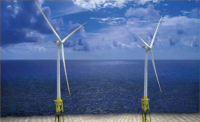The Biden Administration on Oct. 30 picked three interregional transmission projects for the first allotment of a $2.5-billion investment fund created under the 2021 infrastructure law. It allows the U.S. Energy Dept. to buy capacity in eligible projects to overcome financial hurdles.
Projects picked for the first $1.3 billion cross six states and will add 3.5 GW of grid capacity.
Under the program, DOE said it will buy up to 50% of capacity for up to 40 years in a project that is in a “national interest electric transmission corridor” that crosses regional transmission organizations or more than one state, and would not be built without federal support.
The agency would later sell the contract to recover its costs.
Energy Secretary Jennifer Granholm said Interregional grid capacity needs to expand five times beyond what it is today.
Related Links:
ENR 2023 Top Owners Sourcebook (PDF)
(Subscription Required)
ENR 2023 Top Owners Sourcebook (Articles)
DOE's final national transmission needs study, also released Oct. 30, concluded that by 2030 "large relative deployments of interregional transfer capacity are needed between the Delta and Plains, Midwest and Plains, and Mid-Atlantic and Midwest regions to meet future demands of the power grid."
The agency said that "by offering capacity contracts, it increases the confidence of additional investors, encourages additional customers to purchase transmission line capacity, and reduces the overall risk for project developers."
East, West, SW Projects Get Funding
One proposed project selected is Cross-Tie, a $750-million, 1.5-GW project planned by a developer partly owned by investment giant Berkshire Hathaway to connect transmission in Utah and Nevada that would allow those states, California and Wyoming to import and export renewable energy. Construction is set to begin in early 2025 and take two years.
Also picked is the first 175 miles of the 248-mi, 1-GW Southline project from New Mexico to Arizona meant to unlock renewable energy potential. The bi-directional line planned by Grid United, Black Forest Partners and Hunt Transmission Services also will improve grid reliability along the border. Construction would begin in early 2025, with the first phase completed in 2027 and the second in 2028.
With the federal infusion, "Southline’s timeline will be meaningfully accelerated to reliably and cost-effectively deliver new resources to meet the region’s growing energy needs,” said Doug Patterson, managing partner of Black Forest Partners.
The third project is Twin States Clean Energy Link, a $2-billion, 1.2-GW transmission line proposed by National Grid and non-profit Citizens Energy Corp. on a 211-mi route in Vermont and New Hampshire to the Quebec border. The high-voltage, direct-current line would deliver Canada hydropower to New England and allow excess clean energy produced there to flow back as offshore wind is developed. Work would start in late 2026.
Specific funding terms for projects now being negotiated include community benefit investments and will be final in early 2024, DOE said, adding that the next Transmission Facilitation Program solicitation would be released by mid-year.





Post a comment to this article
Report Abusive Comment